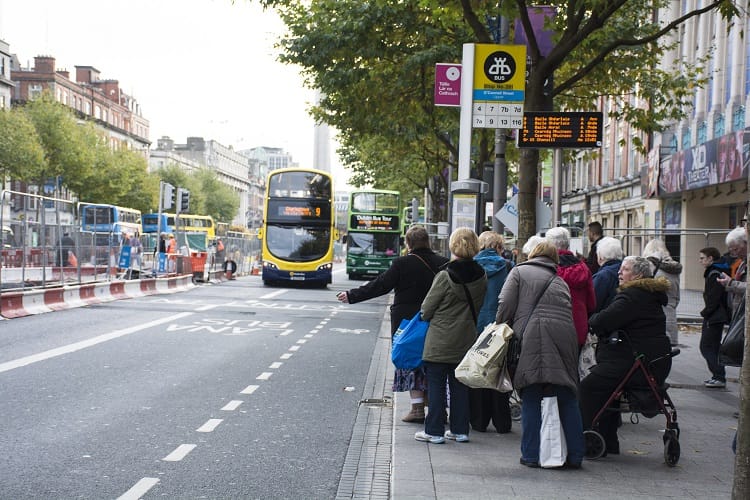What’s the best way to tell area residents about plans for a new asylum shelter nearby?
The government should tell communities directly about plans for new asylum shelters, some activists and politicians say.
Drivers also say they’re disgruntled they weren’t consulted earlier. The consultant behind BusConnects says all feedback is welcome, but the interests of drivers and passengers don’t always align.

“I’m on the first 16 out this morning,” says Dublin Bus driver Martin O’Toole.
For 12 years, O’Toole has driven this route from Santry on the northside to Sandyford on the southside. “The same customers are on my bus all week,” he says.
Many access Beaumont Hospital along the way, his route weaving in and out of housing estates.
Under BusConnects – a proposed redesign of the network championing a straight-line network with interchanges to circular routes – O’Toole says he worries about how these communities in those neighbourhoods he drives through will be affected.
As the BusConnects consultation rolls on, some drivers say they are disgruntled that they weren’t consulted earlier on.
“Drivers are on the ground,” says Tom O’Connor, shop steward of the National Bus and Railway Union (NBRU). “They know their routes, they know their customers, they know schools, shops, hospitals.”
Jarrett Walker, the US-based transport consultant who has led the redesign, said he values all feedback – including the drivers’ – on the proposed plans.
At times, though, there can be a tension between bus drivers’ interests and customers’, he says. “We are clear about who we are ultimately trying to please.”
The network redesign proposes 16 high-speed radial corridors across the city, and 11 orbital routes, which would form circles so riders could bypass the city centre.
This plan would mean more passengers having to change buses – but with the kicker that if buses are more frequent, Dubliners and visitors would get where they’re going a lot faster.
As Dubliners wrap their heads around the logic of interchanges, some local representatives in areas such as Drimnagh have raised concerns about whether enough consideration has been given to disabled and elderly passengers.
O’Toole, who is based at the Summerhill Bus Depot, says he has worked for Dublin Bus for 18 years. For 12 of those, he has driven then 16 route.
“That route goes down Collins Avenue, onto Beaumont Road, onto Shantalla Road and back out onto the Swords Road,” says O’Toole. “That catchment area, there’s a lot of elderly people.”
Under BusConnects, O’Toole’s 16 route would be replaced by the A route.
Current plans would see buses on the A route run every five minutes during a normal weekday down its main spine running from Whitehall to Terenure. That’s more frequent than at the moment.
But O’Toole says that 400 metres – which is the maximum distance people anywhere in the city should have to walk to a new stop under the plans – is too far for an elderly or disabled person who might have had years of a stop outside their house.
Mark Moloney, another bus driver, says he thinks drivers are best-placed to consult on this redesign. “And we haven’t been asked,” he says.
He has worked for Dublin Bus for 12 years as a “spare driver”. That means he drives different routes assigned to a particular garage, in his case, the Ringsend Depot on the southside.
Driving routes 1, 27, 15, 56a, 49 and 55, Moloney covers much of south and southwest Dublin. “Tallaght and Templeogue are my main catchment areas,” he says.
He says he worries what a network redesign might mean for certain passengers. “We’ve to take into consideration that we’ve different segments of passengers on our buses,” he says.
Take the 27 route, which runs from Clarehall near Coolock to Jobstown in Tallaght. “I’ve disabled people, people in wheelchairs, people with small kids in prams, blind passengers,” says Moloney.
Dublin’s bus network developed over time with communities developing around parts of the present day network, says Moloney.
He worries that an interchange system will “discommode” certain passengers. As Moloney tells it, drivers are more “aware of certain passengers and their needs”.

Since BusConnects was launched in June, tensions have increased between the NBRU and US-based consultant Walker, particularly on Twitter.
On one hand, the NBRU’s O’Connor argues that drivers should have been consulted ahead of the redesign.
On the other, Walker argues that misinformation and misleading information has complicated discussion.
As to whether drivers should have been consulted earlier, Walker says that “bus drivers work for operating companies and the operating companies work for the National Transport Authority (NTA)”.
Dublin Bus, he says, were “intimately involved in the development of the plan” and “one of their roles was to make sure the plan was reasonable in terms of the bus driver experience”.
Walker says he assumes drivers were involved in internal discussions “but you would have to ask Dublin Bus about this”.
Dublin Bus says it has engaged with all its employees in relation to the redesign, said a spokesperson.
“As part of the current phase of public consultation on the proposed redesign, Dublin Bus is assisting the National Transport Authority in facilitating information sessions throughout the city and these will also take place in our own depots next month’” they said.
It would be inappropriate for the NTA to have told Dublin Bus how to discuss matters within their company, says Walker.
Bus drivers (and anyone else) can give their thoughts by filling out a survey on the National Transport Authority website, or email in before 28 September.
Get our latest headlines in one of them, and recommendations for things to do in Dublin in the other.